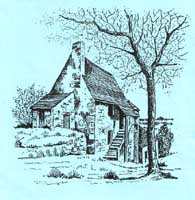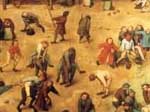
Musée de la Devinière
15th century birthplace of Rabelais
A Brief Study Guide for Gargantua
 |
Musée de la Devinière |
Rabelais was a monk, law student and medical doctor, highly educated for his day. He also employs dialect, proverbs and even words that he made up. So much of his writing is addressed to others educated in the same tradition that it can be a bit obscure for us. Read the book through, understand what you can, and don't worry if you don't understand everything.
| Download a printer-friendly version of the study guide |
"Advice to Readers" and "Prologue": Read this fairly carefully. It is here that Rabelais clues you in to the fact that even though his writing appears frivolous, he is treating serious subject matter. Also notice the theme of drinking and thirst (which runs through the entire book). This is generally considered a metaphor for Rabelais' thirst for knowledge, characteristic of the Renaissance in France.
Chapters 1 - 13: Read through this but don't worry too much about it. We will explain the pertinent parts when we discuss the book. It is primarily these early chapters which exhibit what is called "Rablelaisian humor", i.e. vulgarity and scatological language. It is important in that Rabelais is satirizing all things medieval. Later you will notice the refinement of the new values he is advocating. In this part of the book, Rabelais also uses the fact that his characters are giants for humorous effect. As the book progresses, he (and we) seem to forget that they are giants. We will talk more about this too. The fact that Gargantua is a giant is also symbolic of man's stature in Rabelais' new world view.

|
Rabelais list of 215 games in Gargantua Book XX may have inspired Bruegel's 1559 painting Children's Games. |
Chapters 14 - 24: In these chapters, Rabelais is making fun of the medieval system of education and poor hygiene. There is still a good deal of humor and bawdiness. Note particularly the characteristics of the education he is criticizing. See if you can determine what other customs and institutions he is satirizing. We will discuss in detail Chapters 23 and 24 where Rabelais outlines what he sees as the ideal education. You will have an assignment relating to these two chapters.
Chapters 25 - 50: This is the main part of the book that we will be discussing. These chapters deal with the Pichrocholine war. We will be visiting the site where this war takes place near Rabelais' childhood home. Notice his attitudes towards war and again try to see if you can tell what values he is criticizing. You will not understand all of the allusions, but we will explain them later. Parts of this section are also a satire of the medieval epics such as The Song of Roland and the medieval conception of the hero.
Chapters 51 - 58: This part of the book deals with the Abbé de Thélème and presents Rabelais' idea of a utopia. It is important to contrast it with the earlier chapters. Here and in the chapters on education, we see his advocacy of Renaissance humanism. We will also discuss these chapters since we will be discussing various kinds of dwellings and modes of living in the course. Notice the change of tone to one of seriousness (no giants, no vulgarity, little humor) and try to note the characteristics of the life style and values Rabelais is advocating.
Assignments: You will be writing short essays in your journal on some parts of the book. These will deal with education, the war and the Abbé de Thélème. We know some parts are difficult. Make a note of whatever you don't understand and we'll do our best to explain it. (By the way, don't worry about the riddle or conundrum. Nobody understands them.)
This page was meant to be viewed in frames. |
 Return to Return toAmelia Carr's Home Page |